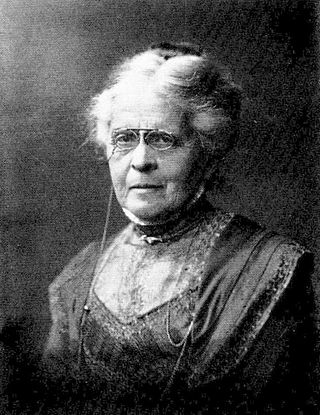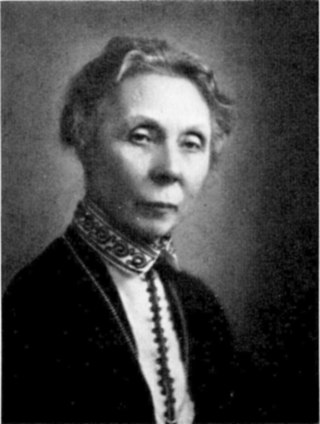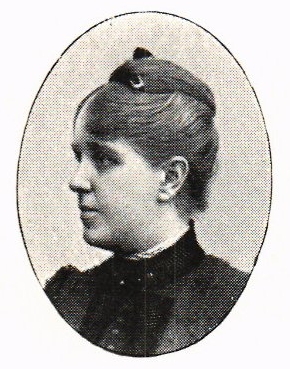
Ellen Karolina Sofia Key was a Swedish difference feminist writer on many subjects in the fields of family life, ethics and education and was an important figure in the Modern Breakthrough movement. She was an early advocate of a child-centered approach to education and parenting, and was also a suffragist.

Mårten Eskil Winge was a Swedish artist. He was a professor at the Royal Swedish Academy of Arts. He was associated with the Düsseldorf school of painting. His art was influenced by the Norse mythology themes also found in works by Nils Blommér (1816–1853) and Carl Wahlbom (1810-1858).

Carin Sophie Adlersparre, known under the pen-name Esselde was one of the pioneers of the 19th-century women's rights movement in Sweden. She was the founder and editor of the first women's magazine in Scandinavia, Home Review, in 1859–1885; co-founder of Friends of Handicraft in 1874–1887; founder of the Fredrika Bremer Association (Fredrika-Bremer-förbundet) in 1884; and one of the first two women to be a member of a state committee in Sweden in 1885.

Eva Fredrika Bonnier was a Swedish painter and philanthropist.

Johan Fredrik Höckert was a well-known Swedish artist from Jönköping known for his colorful, dramatic oil paintings depicting historical events. He is one of the most famous nineteenth-century painters in Sweden, and one of the painters most often associated with Swedish national romanticism.

Johan Christoffer Boklund was a Swedish history, genre, and portrait painter from Kulla-Gunnarstorp in Scania. He was the son of a gardener. At the age of fifteen, Boklund came to Lund, where he worked on illustrations for Sven Nilsson's works on Scandinavian fauna. He then became a student at the Royal Danish Academy of Fine Arts in Copenhagen where J. L. Lund was his teacher.

Agda Georgina Dorothea Alexandra Montelius née Reuterskiöld was a Swedish philanthropist and feminist. She was a leading figure of the Swedish philanthropy, active for the struggle of women's suffrage, and chairwoman of the Fredrika Bremer Association in 1903–1920.

Ellen Fries was a Swedish feminist and writer. She became the first female Ph.D. in Sweden in 1883. She also founded several women's organizations.

Agnes Fredrika Börjesson, sometimes called Agneta, was a Swedish painter who specialized in genre and historical scenes.
Wilhelmina "Mina" Josephson, was a Swedish pianist. She was regarded as one of the most notable concert pianists in contemporary Sweden. She had several well known pupils. She is also known as a friend of Jenny Lind.

Hilda Augusta Amanda Kerfstedt, née Hallström, was a Swedish novelist, playwright and translator. She was a popular and noted writer in late 19th and early 20th century Sweden, and participated in public debate. She was also engaged in the movement for women's rights, and active in the Fredrika Bremer Association and Married Woman's Property Rights Association. As a feminist, she focused on the debate around sexual equality, and was critical to the contemporary sexual double standards for men and women. As such, she was one of the participants in the Nordic sexual morality debate, the public debate in Swedish papers, books and plays, which took place during the 1880s. Kerfstedt was a member of the women's association Nya Idun and one of its first committee members. She was the editor of the feminist paper Dagny, the publication of the Fredrika Bremer Association, in 1888–1891. She was especially noted within the debate on children's literature.

Calla Curman, née Lundström, was a Swedish writer, salon-holder and feminist. She was also the founder of Stångehuvud nature reserve and one of the five founders of the women's association Nya Idun.

Anna Katarina Fredrika Munthe-Norstedt was a Swedish painter known for still-lifes and interiors. She also worked with genre painting and portraits.

Louise Nathalie Adelborg was a Swedish porcelain designer and textile artist.

Ane Gurli Linder née Peterson (1865–1947) was a Swedish writer and feminist who was active in Stockholm's social life in the late 19th century when she also encouraged women to become more directly involved in culture. A strong supporter of libraries and reading, she later played an important role in pioneering the promotion and development of children's literature.

Kaisa Brita Melanton née Björklund (1920–2012) was a pioneering Swedish textile artist who is remembered in particular for the large, post-modernist works she created for local authorities, theatres and churches. She employed a variety of techniques including embroidery and weaving. From 1969 to 1979, she served as head of the textile department at Konstfack, the Swedish University of Arts, Crafts and Design, and in 1974 was elected a member of the Royal Swedish Academy of Fine Arts.

Inga Thyra Carola Grafström was a Swedish textile artist.

Sigrid Amalia Leijonhufvud was a Swedish author, historian, and feminist, who is best known for authoring biographies of historical women. She was granted membership in the Samfundet De Nio and was awarded the Swedish royal medal Litteris et Artibus in recognition of her writing career.

Nya Idun is a Swedish cultural association for women founded in 1885, originally as a female counterpart to Sällskapet Idun. Its aim was to "gather educated women in the Stockholm area for informal gatherings".

Hilma Hildegard JosefinaSvedbom née Lindberg was a Swedish pianist.


















